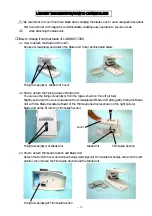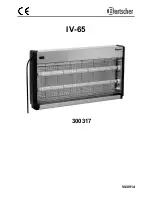
check that the tiller has not damaged functional parts and has all mechanical parts in good
condition. Repair and / or replace the damaged parts;
check that the tiller has no missing parts (pins, safety pins, plugs oil ...). Restore the missing
parts;
check that all guards and safety devices have no damages and are properly positioned. Repair
and / or replace the damaged shielding, restore the correct position;
verify that the PTO driveshaft is properly installed (see section: Connection of the drive shaft);
check that the driveshaft clutch is in good condition, and that its components are not subject to
"sticking" (see section: Maintenance / Driveline);
check the presence of lubricant in all greasing points of the tiller (driveshaft, supports...) (see
sect. Maintenance / Driveline and Maintenance / Support rotor);
check for oil leaks from the gearbox or the transmission side cover. Identify the reason of loss,
then repair and / or replace the damaged components;
check the correct oil level in the gearbox and in transmission side box (see section maintenance);
check that blades are not excessively worn and the relating hardware is correctly tightened (see
sect. Maintenance);
check that all the tiller hardware is properly tightened. Refer to the tightening table in the manual
for proper torque values;
check that all safety decals are correctly positioned, in good condition and legible. Replace any
damaged decals;
check that there is no constraints that may prevent the movement of equipment. Remove any
constraint.
Before the start up and before each use, make the following checks on the operating area identified
for tillage:
check that area is clear of foreign objects (rocks, branches or debris). Remove any obstacle and
visibly highlight obstacles that cannot be eliminated (e.g. by means flags);
make sure in the working area exposed there are no people or animals;
make sure the soil to be worked is not too grassy, muddy, sandy or rocky.
WARNING
Before conducting the above inspections and service, make sure the tractor engine is off, all rotation
parts are completely stopped and the tractor is in park with the parking brake engaged. Make sure
the tiller is resting on the ground or securely blocked up and the tractor lifting hydraulics locked.
Once all the checks above have been done, start tractor and the tiller as follows:
start the tractor and engage the tractor PTO at low rpm, making sure that the tiller is NOT in the
raised position but close to the ground, then increase speed engine until to 540 rpm;
lower the tiller on the ground and simultaneously start driving the tractor at low speed.
Subsequently increase the ground speed depending on ground conditions;
If the environmental temperature is very cold , it's recommended to wait a few minutes with the
PTO of the tractor at low rate before lowering the tiller completely on the ground;
drive for a while operating the tiller, then stop the tractor to check the quality of the work
performed. If you need to get off the tractor, lift the tiller just out of the ground, reduce engine
speed and disengage PTO, set the parking brake, stop engine and remove the ignition key;
If the working depth and/or soil texture are not as desired, correct them by adjusting the skids
and/or the rear cover (see section Adjustments).
Summary of Contents for FTC Series
Page 2: ......
Page 39: ...PARTS MANUAL FTC SERIES ...
Page 40: ... FRAME ASSEMBLY SPARE PARTS TABLE ...
Page 41: ... FRAME ASSEMBLY SPARE PARTS LIST FRAME ASSEMBLY FTC SERIES 085 105 125 ...
Page 43: ... SIDE ASSEMBLY SPARE PARTS LIST SIDE DRIVE ASSEMBLY FTC SERIES 085 105 125 ...
Page 45: ... GEARBOX ASSEMBLY SPARE PARTS TABLE GREABOX ASSEMBLY SPARE PARTS LIST ...
Page 47: ... ROTOR ASSEMBLY SPARE PARTS LIST ROTOR ASSEMBLY FTC SERIES 085 105 125 ...
Page 49: ...NOTES ...
















































